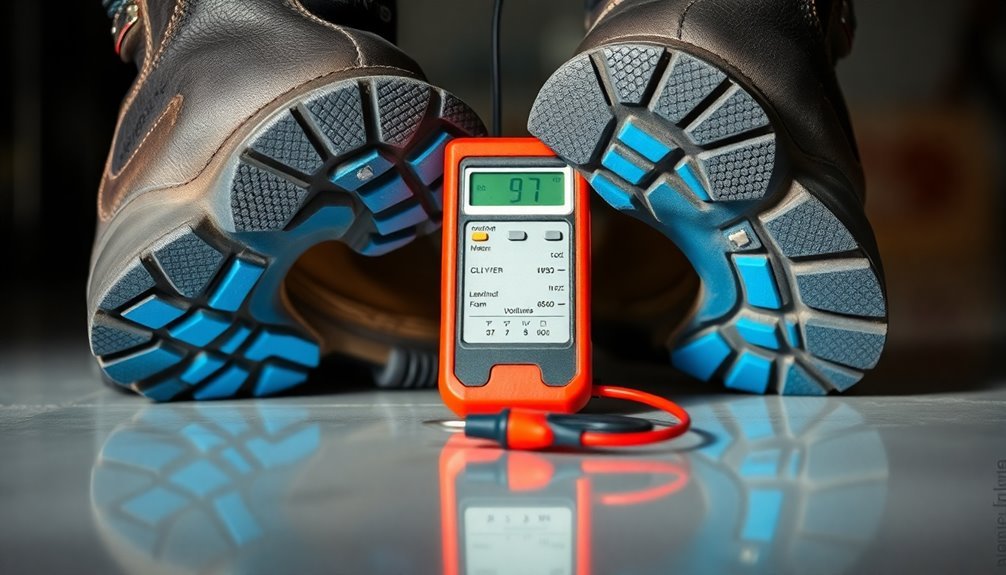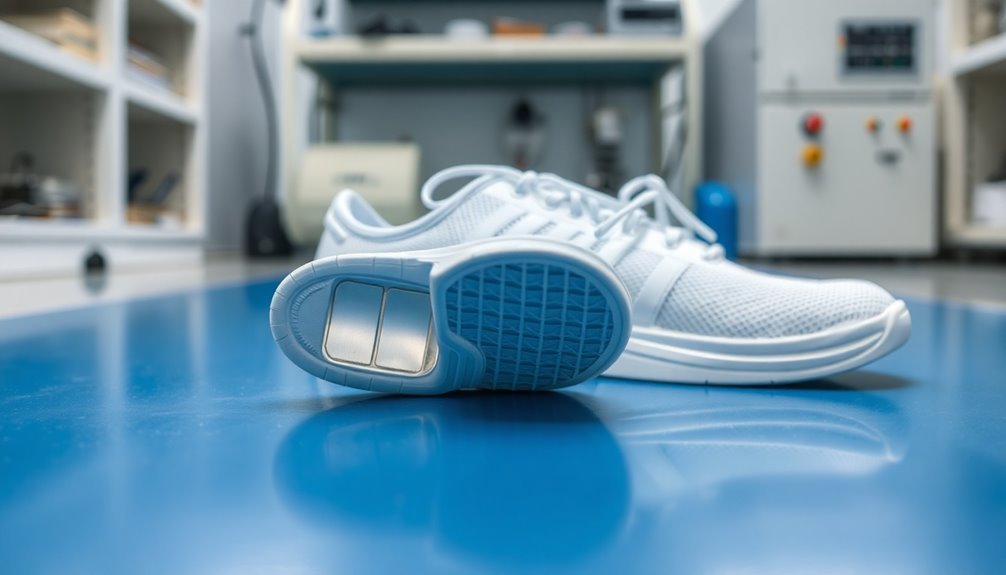Static control footwear must meet rigorous standards like EN IEC 61340-4-3 and ANSI/ESD STM9.1 to protect against electrostatic discharge in industrial settings. You'll need to guarantee your footwear meets specific resistance requirements, typically between 10^6 and 10^8 ohms for static dissipative (SD) shoes, and below 500,000 ohms for conductive (CD) footwear. Regular testing using metal plate electrodes verifies compliance, while proper maintenance keeps the protective properties intact. Your industry may require additional specifications, from clean room protocols to hazardous material handling standards. Understanding these thorough requirements will help you maintain a safer workplace environment.
Understanding ESD Footwear Standards

While workplace safety encompasses many aspects, understanding ESD (Electrostatic Discharge) footwear standards is essential for protecting both personnel and sensitive electronic equipment.
The primary standards you'll need to know are EN IEC 61340-4-3 and EN IEC 61340-5-1, which specify electrical resistance requirements between 0.1 MΩ and 100 MΩ for ESD footwear.
You'll find that EN ISO 20345 and EN ISO 20347 complement these electrical specifications by setting additional safety requirements. EN ISO 20345 mandates features like closed heel areas and resistance to fuel oils, while EN ISO 20347 focuses on occupational footwear standards. The shoes must include impact-resistant toe caps that can withstand forces up to 200 Joules.
To verify compliance, you should always look for the yellow ESD symbol marking on the footwear.
When selecting ESD footwear, you'll need to confirm it meets these standards while considering your specific workplace requirements. The footwear must maintain consistent electrical resistance within the specified range, incorporate proper construction features like closed heels, and provide adequate protection against workplace hazards.
Remember that compliance with these standards isn't optional – it's a critical component of your facility's static control program and overall safety strategy.
Testing Methods and Measurements
Testing ESD footwear requires rigorous standardized methods and precise measurement equipment to guarantee compliance with safety regulations. You'll need to follow specific test methods like ASTM F2412 and EN 61340-5-1, which measure static electricity resistance and contact resistance respectively. To determine slip resistance properties, test specimens are mounted on a moveable rigid sled and subjected to gradually increasing horizontal force.
| Test Parameter | Measurement Method |
|---|---|
| Contact Resistance | Metal plates with electrodes |
| Static Dissipation | Footwear conductivity testers |
| Environmental Control | Conditioning chambers |
| Friction Testing | SATRA TM35 sled system |
| ESD Compliance | ESD meter kits |
Before testing, you must condition your footwear samples in controlled environments with specific temperature and humidity levels. The testing process involves filling shoes with stainless steel balls or shot pellets and applying predetermined weights (typically 4 kg or 12.5 kg). You'll measure resistance by applying test voltages and recording measurements over time.
For certification, your footwear must meet strict resistance thresholds – below 100 megaohm for ESD compliance. You'll need to use commercial footwear conductivity testers like the Newson Gale TM II to verify these requirements. Remember to document all measurements and confirm proper labeling with the yellow ESD symbol for compliant footwear.
Safety Classifications and Requirements

Having established proper testing protocols, you'll need to understand the distinct safety classifications for static control footwear. Each classification serves a specific purpose and comes with unique requirements for workplace safety.
EH (Electrical Hazard) footwear reduces electricity flow to ground, protecting you from electrocution. You'll find the EH marking on ASTM-labeled safety-toe shoes, though its effectiveness diminishes with wear and moisture exposure. Regular inspection of the outsoles for wear is critical to maintaining the footwear's protective properties.
SD (Static Dissipative) footwear helps prevent static buildup by conducting charges from your body to ground, requiring specific insoles and sock restrictions to maintain functionality.
If you're working in munitions or fireworks facilities, you'll need CD (Conductive) footwear, which safely conducts static electricity to ground. However, don't use these near open electrical circuits.
For work involving energized power lines or underground electrical systems, you'll want DI (Dielectric) footwear, which provides vital isolation from electrical hazards.
You'll notice that all these classifications, except DI footwear, must meet ASTM requirements for toe impact and compression resistance. Each type displays its classification prominently on the ASTM label, making it easier for you to select appropriate footwear for your specific work environment.
Contact Resistance Specifications
Through detailed contact resistance specifications, you'll find distinct ranges for different types of static control footwear. Antistatic footwear must maintain electrical resistance between 0.1 and 1000 megaohms according to EN ISO 20344, while ESD footwear requires a narrower range of 0.1 to 100 megaohms under BS EN IEC 61340-4-3.
Regular monitoring of footwear performance is essential as wear and tear can significantly impact the shoe's antistatic and ESD capabilities over time.
If you're working with conductive footwear under ASTM F2413-11, you'll need to guarantee electrical resistance remains below 500,000 ohms. For static dissipative (SD) footwear, the requirements fall between 10^6 and 10^8 ohms.
It's crucial to note that these measurements aren't just about the footwear itself – they include the entire system resistance, incorporating the person, footwear, floor surface, and ground resistance as specified in ANSI/ESD STM97.2-2016.
When you're testing ESD capability under EN 61340-5-1, your person-shoe-ground system must measure less than 35 megaohms. The laboratory testing process involves specific conditions, including preconditioning the footwear in controlled temperature and humidity environments before measuring contact resistance using a stainless steel plate and insole electrode setup.
Workplace Hazard Protection

You'll need to implement specific electrical shock prevention measures when working with static-sensitive equipment, including wearing properly rated ESD footwear and maintaining consistent grounding practices.
Your workplace risk assessment should identify areas where static discharge poses significant hazards, particularly in electronics manufacturing, data centers, or facilities handling flammable materials. The electrical resistance range of 1 x 10^6 to 1 x 10^8 ohms in ESD footwear provides optimal protection while maintaining safety.
To guarantee thorough protection, you must pair ESD footwear with complementary safety measures like conductive flooring and regular testing of contact resistance between your shoes and the ground.
Electrical Shock Prevention Measures
Safety protocols for preventing electrical shock hazards form the foundation of any thorough workplace protection program. You'll need to implement thorough measures that protect workers from electrical risks while verifying proper equipment maintenance and operation.
| Prevention Measure | Implementation |
|---|---|
| Training Programs | Conduct regular sessions on hazard recognition and proper equipment handling |
| PPE Requirements | Provide voltage-rated gloves, boots, and eyewear for electrical work |
| Circuit Protection | Install GFCIs and maintain proper insulation on all wires |
| Safety Procedures | Enforce lockout/tagout protocols and emergency response plans |
You must regularly inspect all electrical equipment and maintain detailed records of maintenance activities. Workers exposed to confined space hazards require extra precautions and specialized training due to increased electrical risks. Don't overlook the importance of clear safety signage in areas with electrical hazards, and verify you've properly labeled all electrical panels and equipment. When working with sensitive electronics, you'll need to use anti-static footwear with ESD protection and conductive outsoles to prevent static buildup.
Remember to conduct monthly safety audits to identify potential hazards before they cause accidents. You should also verify that all workers understand and follow proper procedures for plugging and unplugging equipment, avoiding circuit overloads, and responding to electrical emergencies.
Risk Assessment Guidelines
Effective risk assessment forms the cornerstone of workplace hazard protection. When evaluating static control footwear requirements, you'll need to follow a structured approach that identifies, evaluates, and controls potential hazards in your workplace.
Start by assembling a diverse assessment team that includes safety experts and employees who regularly wear static control footwear. Begin by consulting key stakeholders to gather valuable insights on workplace risks and specific footwear concerns.
Conduct a thorough workplace walk-through to identify electrical hazards, focusing on areas where static discharge poses risks to equipment or personnel. You'll need to document all findings using a standardized risk assessment template.
Next, evaluate the severity and likelihood of static-related incidents, considering factors like equipment sensitivity and environmental conditions.
Implement control measures starting with engineering controls, such as proper grounding systems, before moving to administrative controls and personal protective equipment requirements. You'll want to guarantee your static control footwear program complies with relevant OSHA standards.
Maintain detailed records of your risk assessment findings and regularly review them to adapt to workplace changes.
Train your employees on proper footwear use and maintenance, and establish a safety committee to oversee ongoing compliance and effectiveness of your static control measures.
ESD Control Program Implementation
Implementing an ESD control program calls for a thorough approach that integrates four key elements: training requirements, ESD Protected Areas (EPAs), compliance verification, and technical requirements.
- Your initial focus should be on training – guarantee all personnel receive extensive ESD awareness education, covering both theoretical principles and practical applications of ESD control measures. Top management support is essential for developing and maintaining an effective training program.
- You'll need to establish clearly defined EPAs with proper access controls, signage, and floor marking. Don't forget to equip your team with appropriate ESD footwear that meets ANSI/ESD S20.20 standards.
- You must implement a robust compliance verification system that includes regular testing, calibration, and documentation of all ESD control measures.
- Your technical requirements should be carefully documented in a Qualified Products List (QPL), specifying approved ESD protective products and establishing clear procedures.
You'll want to maintain detailed records of your compliance verification efforts and conduct regular audits to guarantee your program stays on track. Remember, your technical specifications should be tailored to your company's specific needs and the sensitivity of the devices you're handling.
Regulatory Compliance Guidelines

Building upon your ESD control program, regulatory compliance for static control footwear involves adherence to multiple standards and specifications.
You'll need to guarantee your facility meets ANSI/ESD S20.20 guidelines, which mandate that floor-footwear combinations generate no more than 100 volts of static in electronics manufacturing environments.
You must also comply with OSHA requirements for safety footwear, following ASTM F2413 standards for impact and compression resistance. Your workers' safety shoes need built-in toe guards and must meet I/75 and C/75 ratings for maximum protection.
When implementing ESD footwear policies, you'll need to establish clear protocols preventing outdoor wear to maintain static control effectiveness.
Your compliance program should include a thorough workplace hazard assessment and proper documentation of footwear requirements. You're responsible for training employees on correct ESD footwear selection, fitting, and maintenance.
Make sure your workers can easily identify ESD-compliant shoes through visible markings or symbols. You'll need to conduct regular inspections of footwear condition and maintain ongoing training through workshops and safety meetings to guarantee continuous compliance with anti-static regulations.
Performance Testing Procedures
Verifying static control footwear performance requires meticulous testing procedures aligned with EN ISO 20345 and IEC TS 61340-4-3 standards. You'll need specific equipment like the Sole-Mate II tester to measure resistance between shot pellet-filled shoes and steel plates, guaranteeing proper static dissipation capabilities.
Static dissipation testing measures electrical resistance using hand-held metal bars or shot pellets, confirming the footwear's ability to safely discharge electrostatic charges.
Slip resistance testing calculates the dynamic coefficient of friction using specialized surfaces and dynamometers under the UNE-EN ISO 20344:2012 standard.
Material testing follows SATRA TM35 protocols to evaluate static friction between components, particularly for heel grip and upper materials.
Performance verification includes impact resistance, compression resistance, and puncture resistance testing per ASTM F2413 requirements.
You'll need regular testing to maintain compliance, as static dissipative properties can change with use. Third-party testing guarantees your footwear meets minimum performance requirements, and proper labeling must indicate the specific protection criteria met.
This extensive testing approach helps maintain safety standards in hazardous environments where static control is vital.
Industry-Specific Applications

Different industries face unique static control challenges that call for specialized footwear solutions. In electronics manufacturing and clean room environments, you'll need ESD footwear that meets ANSI/ESD S20.20 standards, guaranteeing no more than 100 volts of static generation to protect sensitive components and equipment.
For hazardous environments where you're working with flammable materials, you'll want to use conductive or static dissipative footwear that rapidly discharges static electricity to prevent accidents. These environments require strict adherence to safety standards like IEC TS 60079-32-1 for footwear resistance testing.
If you're working in construction or general industrial settings, antistatic footwear might be sufficient to reduce static-related discomfort and basic hazards. However, you shouldn't use this type of footwear in environments requiring controlled static discharge.
Your choice of footwear should match your specific industry requirements. Clean rooms demand the highest level of static control, while manufacturing facilities might need varying levels depending on the sensitivity of their processes.
Remember to regularly test your footwear according to NFPA 77 guidelines to guarantee it maintains its protective properties throughout its service life.
Frequently Asked Questions
How Often Should ESD Footwear Be Replaced for Optimal Performance?
You should replace your ESD footwear every 200 hours of use or every three months in high-risk industries. Don't wait longer than two years in less strict environments, and replace immediately if they fail resistance tests.
Can Regular Cleaning Affect the Static Control Properties of Safety Shoes?
Yes, improper cleaning can damage your ESD shoes' conductive fibers. You'll maintain ideal static control by using neutral detergent and lukewarm water, while avoiding harsh scrubbing, soaking, or extreme temperatures.
What Temperature Conditions Impact the Effectiveness of ESD Footwear?
You'll find your ESD footwear's effectiveness changes with temperature extremes. High temperatures with low humidity can reduce conductivity, while cold conditions may affect the materials' discharge properties. Class 1 footwear performs best in extreme conditions.
Are ESD Shoe Covers as Effective as Permanent ESD Footwear?
No, you'll find that ESD shoe covers aren't as effective as permanent ESD footwear. They provide less consistent protection, generate more particles, and can be compromised by poor contact or improper use.
Do Medications or Personal Care Products Affect Static Control Footwear Performance?
While there's no direct evidence that medications affect your static control footwear, personal care products like moisturizers might enhance conductivity. You don't need to worry about these items compromising your footwear's static control performance.
In Summary
You'll need to stay up-to-date with static control footwear standards as they evolve in your industry. By following proper testing protocols, meeting safety classifications, and maintaining compliance with ESD control programs, you're protecting both workers and sensitive equipment. Remember to regularly verify your footwear's performance and contact resistance specifications to guarantee continued effectiveness in your workplace's static-sensitive environments.





Leave a Reply